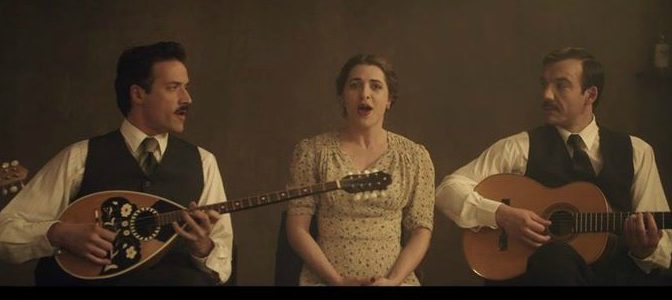CLOUDY SUNDAY tells the love story between a Jewish girl and a Christian boy during the German occupation in Thessaloniki in 1942. It is based on the book “Ouzeri Tsitsanis” by George Skarbadonis which was inspired by real events. Day Moibi sat down with director Manoussos Manousakis.
Cloudy Sunday is based on the novel Ouveris Tsitsanis. How did you find adapting this novel for the screen?
Adapting a novel in to a script is a very hard venture as novel and script are two completely different writing arts with completely different narration rules.
What I do is to learn the book by heart, engulf its ideology and inner meaning and then act liberally because I am sure that thus I will not betray the author’s intentions. A book is a great asset for a scriptwriter as it sets the characters and the action but then the scriptwriter has to be free to interact with the material and come up with a new creation.
The film is set in Nazi Occupied Greece, reliving some of the tragedies from that time. How much of the film came from reality? Were there any specific scenes that come from true stories?
All the historical events are accurate and come from true stories. For example, if you see the photographs taken at that time, from the gathering in Liberty Square you will recognize the exact reenact ion of them in the film. Furthermore, the ethics of the era are being reproduced with solemn accuracy. The personal stories of the heroes are fiction but they very well might have happened considering the characters of our heroes.
There are certain scenes that are, understandably, quite brutal- though never graphic or excessive. How difficult did you find making that balance?
One must be very careful not to fall in the trap of visual excess. I try to be the audience of my film and thus judge the posology that feels right for me as audience. This is a little bit schizophrenic but it is a good rule and a very valuable, and sometimes severe, lesson for a film maker.
The addition of Lela’s story brought an interesting dynamic to the film, and takes a dark turn. What inspired you to create that character’s storyline?
I wanted to create an everyday lay girl to represent the ethics of everyday life. Lela has a talent, she falls in love with her mentor, a very easy thing to happen and after being desolate, she grabs onto a strong, rich, powerful man to drag herself away from misery. When she finds out his real doings, she does not hesitate to give him up, knowing she will lose everything. This is the ethics of a non-hero, an everyday person that at the point of crisis will stand on his/her feet and protect the social coherence.
How easy was it picking the cast for this film?
Picking the cast of a film is a magical procedure. The actor walks in your office, sits in front of you and then you know. By the aura she or he radiates, by their little everyday movements i.e. from the way they would hold their coffee cup, from the way they express their nervousness, you know that she or he is unique and the only one for the part.
With thousands of extras and a variety of on-set locations, how much of a task was completing this film?
It was the most fantastic and joyous adventure doing this film. We had to deal with thousands of extras, whom I like to call “supporting stars” as they all gave their soul to reenact the history of their city. Everybody knew what to do, I would only give a small introduction of the historical event that we would reenact and everybody was getting into the feeling, digging up personal memories from their parents or grandparents stories.
We “swam” in to the past like crossing a hospitable lake with the help of all these volunteers, because that is what they were, volunteers. And this is fantastic, that so many people for hours and hours, for days and days, they were there, eager to participate and donate their souls for the film. I am grateful to them.
As for the versatility of locations, this was a problem because much of the architectural reminiscence of the past has been torn down except for some very few exceptions. But, our set designer performed miracles from scratch. On the other hand, museums, synagogues, and the combination of many city squares, with little intervention were used to create this era.
Music is such a huge part of this film, especially considering the lead character of Vassillis Tsitsanis. How much were you inspired by his music, and what was your aim in adapting it?
Vasilis Tsitsanis music was the inspiration for the music score of the film. We had two challenges. The first was to recreate the atmosphere of the club, the sound of non-electrical instruments and the natural singers voice with no amplifiers. All these had to be recorded electronically and the task of the sound designer was to make it sound non – electronic. That was a daring encounter for our sound designer Manolis Manoussakis (my son). The second challenge was to orchestrate Tsitsanis music so the score of the film would be based on his mellodies. The composer of the film, Themis Karamouratidis, performed miracles. Being faithful to Tsitsanis’ original melodies he created the score of the film transforming these melodies so they would underline the emotions generated by the film.


